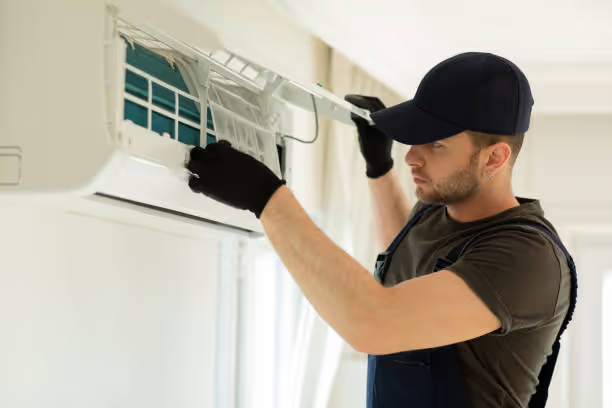AC Service in Coram, NY
Keeping your home comfortable through hot, humid Long Island summers starts with reliable, expert AC service in Coram, NY. Whether your system is struggling to cool, consuming more energy than it used to, or making unusual noises, timely professional attention prevents bigger breakdowns and higher utility bills. This page explains common problems local homeowners face, the types of AC services available installation, repair, replacement, tune-ups, emergency response, and service agreements—and what a thorough, professional service process looks like in Coram homes.

Common AC issues in Coram, NY
Coram’s humid summers, occasional heat waves, and aging housing stock create a predictable set of AC problems:
- Poor cooling or uneven temperatures between rooms
- High energy bills from inefficient or undersized systems
- Frequent short-cycling or system shutdowns
- Weak airflow caused by clogged filters, obstructed vents, or blower issues
- Refrigerant leaks or loss of cooling capacity
- Frozen evaporator coils from airflow restriction or low refrigerant
- Corrosion or debris buildup on outdoor condensers due to pollen and coastal air
- Thermostat or control failures, especially in older systems
Understanding the root cause helps you make the right choice repair, upgrade, or replace based on safety, reliability, and long-term cost.
Full range of AC services for Coram homes
Professional AC service in Coram should cover the lifecycle of your system:
- Installation: Site evaluation (load calculation, duct assessment, electrical capacity), equipment selection (match capacity to home size), proper refrigerant line sizing and secure mechanical installation.
- Repair: Diagnosis and repair of compressors, capacitors, contactors, fan motors, refrigerant leaks, control boards, thermostats, and duct issues.
- Replacement: Options for high-efficiency central AC, ductless mini-splits, and heat pump systems with guidance on right-sizing, SEER ratings, and expected performance.
- Tune-ups / Preventive Maintenance: Seasonal inspections including refrigerant levels, coil cleaning, filter replacement recommendations, electrical checks, and system performance adjustments to extend life and optimize efficiency.
- Emergency Response: Rapid troubleshooting and temporary measures to restore safe operation during off-hours or heat emergencies.
- Service Agreements / Maintenance Plans: Scheduled maintenance visits, priority service, documented inspections, and discounts on parts and repairs to reduce unexpected failures.
Diagnostic and service process - what to expect
A thorough diagnostic process separates quick fixes from lasting solutions:
- System history and symptom review: A review of recent performance, noise, runtime, and thermostat behavior helps narrow possible causes.
- Visual & mechanical inspection: Technicians check outdoor condensers, indoor evaporator coils, ductwork access points, and condensate drains for clogs, corrosion, or damage.
- Electrical and controls testing: Voltage, current, capacitors, contactors, and control boards are tested to confirm safe electrical operation.
- Airflow and pressure checks: Blower speeds, duct static pressure, and return/ supply balance are measured to diagnose airflow problems.
- Refrigerant diagnostics: Refrigerant pressures and temperatures are read to identify leaks or improper charge.
- Performance evaluation: System start-up and run checks measure temperature split and cooling capacity; recommendations are based on measurable data.
- Written findings and options: Clear explanation of issues, urgency, expected life, and repair vs replacement options, including energy-savings considerations.
This methodical approach reduces guesswork and gives homeowners the information needed to decide with confidence.
Common repairs and long-term solutions
Quick repairs can restore comfort, but some situations require more comprehensive fixes:
- Routine repairs: Capacitor and contactor replacements, fan motor service, thermostat recalibration, condensate drain clearing, and filter replacement.
- Refrigerant leak repair: Pinpointing leaks, repairing or replacing affected components, and recharging with the correct refrigerant.
- Compressor or condenser failures: Often a sign to consider replacement when repair costs approach a significant portion of a new system, or when the unit is old and inefficient.
- Ductwork improvements: Sealing leaks, insulating ducts in unconditioned spaces, and rebalancing for more consistent cooling.
- Upgrades: Converting to higher SEER systems, zoning controls, smart thermostats, or ductless solutions to improve comfort and lower long-term operating costs.
When considering repairs versus replacement in Coram, factor in system age, frequency of breakdowns, refrigerant type, and projected energy savings from modern equipment.
Brands supported and compatibility
Reliable service covers common residential brands and systems, including central air, heat pumps, and ductless mini-splits. Familiarity with major manufacturers ensures proper parts, correct refrigerant handling, and adherence to manufacturer warranty procedures. Supported brands often include legacy and modern lines—prioritizing correct match of components, controls, and performance specifications.
Financing, promotions, and service agreements
Local AC service offerings often include financing options to spread the cost of installations or major repairs, as well as seasonal promotions or manufacturer rebates that can make upgrades more affordable. Service agreements provide scheduled maintenance visits, priority response during high-demand periods, and predictable upkeep—valuable protections against summertime emergencies in Coram where demand and humidity strain systems.
Why timely AC service matters in Coram
Delaying repairs or skipping maintenance leads to reduced efficiency, higher energy bills, and increased risk of mid-summer failures. Regular tune-ups improve reliability, maintain manufacturer warranty conditions, and can reduce household humidity important in Coram’s climate where excess moisture encourages mold and indoor air quality issues.
Practical seasonal maintenance tips for Coram homes
- Replace or clean filters every 1–3 months during heavy use periods.
- Keep outdoor condensers clear of leaves, debris, and grass clippings; ensure adequate clearances for airflow.
- Check and insulate ducts in unconditioned basements and attics to prevent energy loss.
- Use programmable or smart thermostats to reduce runtime when the home is unoccupied.
- Schedule professional tune-ups before peak summer demand to verify refrigerant charge, clean coils, and test electrical safety.
ConclusionAC service in Coram, NY encompasses diagnostic clarity, dependable repairs, efficient installations, and ongoing maintenance that address the local climate and housing conditions. By focusing on measurable diagnostics, brand-appropriate repairs, and preventive care, homeowners can maximize comfort, improve energy efficiency, and reduce the chance of emergency outages when Long Island heat and humidity peak.
Customer Testimonials
Hear directly from homeowners who trust Bobby O’s HVAC Inc. for fast response times, honest service, and lasting comfort.











